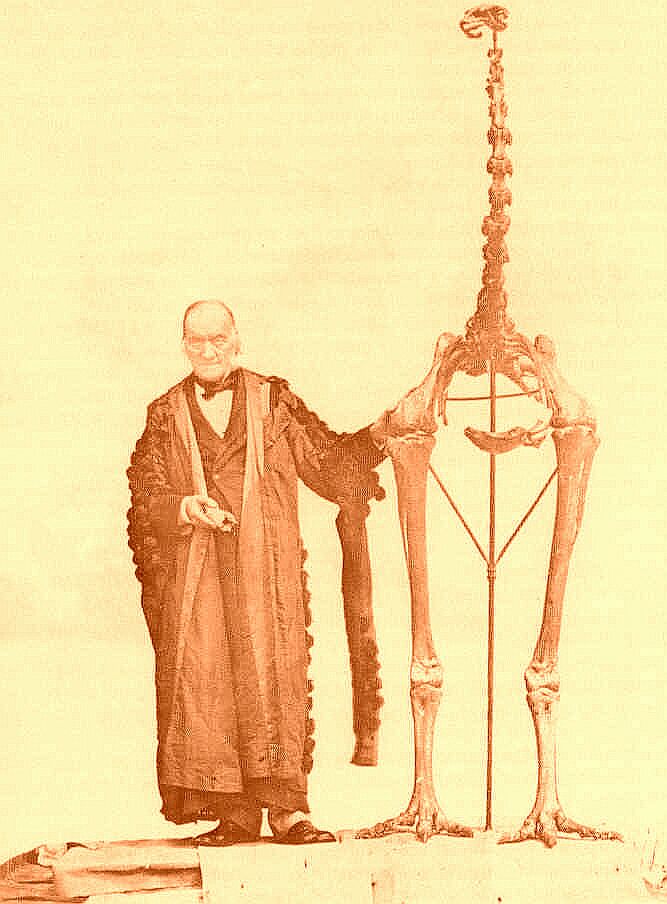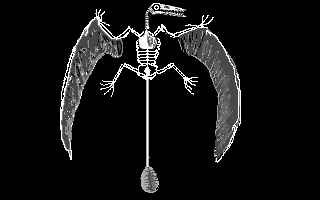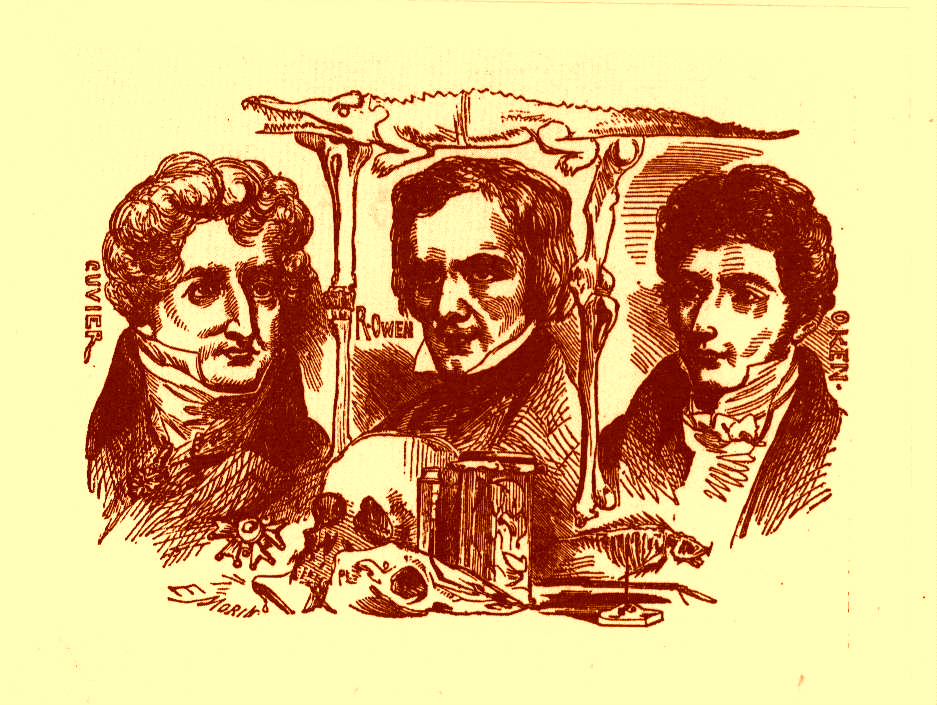Richard Owen
(1804-1892)

"Owen needed a sensible alternative
to transmutation embedded in a non-materialist framework, and he too turned
to German transcendentalism, which he blended and muted with a liberal
appeal to law. Far from the sterile hybrid that Huxley would have us believe,
the union was astonishingly productive. First, it gave him the ideal Archetype,
the 'primal pattern' on which all vertebrates were based. This was a kind
of creative blueprint, "what Plato would have called the 'Divine Idea'".
In practical terms, it was simply a picture of a generalised or schematic
vertebrate; but this in itself provided him with a standard by which
to gauge the degree of specialisation of fossil life, and in 1853 he saw
it as an indispensable aid in determining the true pattern of emergence
'of new living species'."
(Adrian Desmond 1982, p. 43)
"The moral purpose
behind Owen's science is clear: to prove that Man was in the Divine Mind
at the time of Creation. Owen knew of course that not all fossil lines
pointed the human way, in fact only one of many did - still, there was
a timeless purpose behind nature's veneer. Romanticism this was, though
of a typical British variety: shadows of change masked an eternal truth,
a preordained Plan. But Owen was never one to accept the panpsychic mysticism
of the German nature-philosophers, under the influence of F. W. J. Schelling,
the Prince of Romantics. For Schelling nature was immanent in God and the
Divine Intelligence reached out to express itself through a kind of cosmic
poetry. Owen denied that the 'Great Cause of all ' was an 'all-pervading
anima
mundi', the more pointedly, perhaps, because Schelling had actually
pleaded guilty to a sort of pantheism, and Owen himself had been accused
of it by Puseyites. Rather, his God was a traditional British craftsman
working to a blueprint."
(Adrian Desmond 1982, p. 47-48)
"The Archetype is progressively departed from as
the organization is more and more modified in adaptation to higher and
more varied powers and actions."
(Richard Owen 1849a)
"I believe ... that I have satisfactorily
demonstrated that a vertebra is a natural group of bones... and that the
parts of that group are definable and recognizable under all their teleological
modifications, their essential relations and characters appearing through
every adaptive mask."
(Richard Owen 1849a)
"General anatomical science reveals
the unity which pervades the diversity, and demonstrates the whole skeleton
of man to be the harmonized sum of a series of essentially similar segments,
although each segment differs from the other, and all vary from their archetype."
(Richard Owen 1849a)
"The conceivable modifications of
the vertebrate archetype are very far from being exhausted by any of the
forms that now inhabit the earth, or that are known to have existed here
at any period... The discovery of the vertebrate archetype could not fail
to suggest to the Anatomist many possible modifications of it beyond those
that we know to have been realized in this little orb of ours."
(Richard Owen 1849a)
"To what natural laws or secondary
causes the orderly succession and progression of such organic phenomena
may have been committed we as yet are ignorant. But if, without derogation
of the Divine power, we may conceive the existence of such ministers, and
personify them by the term 'Nature', we learn from the past history of
our globe that she has advanced with slow and stately steps, guided by
the archetypal light, amidst the wreck of worlds, from the first embodiment
of the Vertebrate idea, under its old Ichthyic vestment, until it became
arrayed in the glorious garb of the human form."
(the closing paragraph of Richard Owen's
(1849a) address, On the nature of limbs,
delivered to the Royal Institution of Great Britain and
published in 1849,
all from Gould 1986b)
"Organic remains, traced from their
earliest known graves, are succeeded, one series by another, to the present
period, and never reappear when once lost sight of in the ascending search.
As well might we expect a living Ichthyosaur in the Pacific, as a fossil
whale in the Lias: the rule governs strongly in the retrospect as the prospect.
And not only as respects the Vertebrata, but the sum of the animal species
at each successive geological period has been distinct and peculiar to
each period."
(against the doctrine of the Uniformitarian
of Sir Charles Lyell,
Richard Owen 1860b, p. 410-411)
"In regard to animal life, and its
assigned work on this planet, there has.. plainly been 'an ascent and progress
in the main'."
(arguing for progress, Richard Owen 1860b,
p. 411)
"Our most soaring speculations still
show a kinship to our nature; we see the element of finality in so much
that we have cognizance of, that it must needs mingle with our thoughts
and bias our conclusions on many things.
The end of the world has been presented to man's
mind under divers aspects: as a general conflagration; as the same, preceded
by a millenial exaltation of the world to a paradisiacal state, - the abode
of a higher race of intelligences.
If the guide-post of Palaeontology may seem to
point to a course ascending to the condition of the latter speculation,
it points but a very short way, and in leaving it we find ourselves in
a wilderness of conjecture, where to try to advance is to find ourselves
'in wandering mazes lost'."
(on finality, Richard Owen 1860b, p. 412)
"Everywhere in organic nature we see
the means not only subservient to an end, but that end accomplished by
the simplest means. Hence we are compelled to regard the Great Cause of
all, not like certain philosophic ancients, anima mundi, but as
an active and anticipating intelligence."
(on the Creative Power, Richard Owen 1860b,
p. 413)
"Hence we not only show intelligence
evoking means adapted to the end; but, at successive times and periods,
producing a change of mechanism adapted to a change in external conditions.
Thus the highest generalizations in the science of organic bodies, like
the Newtonian laws of universal matter, lead to the unequivocal conviction
of a great First Cause, which is certainly not mechanical."
(concluding remark of the book Palaeontology,
Richard Owen 1860b, p. 414)

Richard Owen with a skeleton of Dinornis torosus HUTTON,
1891;
in his right hand Owen holds the most important bone found by John
Rule,
first moa relic that came to the attention of scientists;
in 1839 Owen announced that giant ostrich-like birds once inhabited
New Zealand
(or even perhaps at that time still lived)...
Go to the bibliography of Richard
Owen




